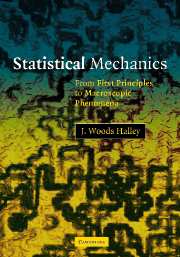Book contents
- Frontmatter
- Contents
- Preface
- Introduction
- Part I Foundations of equilibrium statistical mechanics
- Part II States of matter in equilibrium statistical physics
- 5 Perfect gases
- 6 Imperfect gases
- 7 Statistical mechanics of liquids
- 8 Quantum liquids and solids
- 9 Phase transitions: static properties
- Part III Dynamics
- Appendix: Solutions to selected problems
- Index
8 - Quantum liquids and solids
Published online by Cambridge University Press: 05 June 2012
- Frontmatter
- Contents
- Preface
- Introduction
- Part I Foundations of equilibrium statistical mechanics
- Part II States of matter in equilibrium statistical physics
- 5 Perfect gases
- 6 Imperfect gases
- 7 Statistical mechanics of liquids
- 8 Quantum liquids and solids
- 9 Phase transitions: static properties
- Part III Dynamics
- Appendix: Solutions to selected problems
- Index
Summary
As discussed in Chapter 6, when the temperature is lowered in a classical liquid until the thermal wavelength becomes comparable to the interparticle spacing, then the semiclassical approximation is no longer adequate and quantum effects must be considered. In practice, most classical liquids freeze at all positive pressures before this temperature is reached. The exceptions are the helium liquids (3He and 4He) for which the quantum effects are large enough to prevent freezing as the temperature is lowered while the liquid is kept in equilibrium with its vapor. Conveniently, 3He is a Fermi system and 4He is a Bose system. In these systems as well, phase transitions occur at low enough temperatures. But quantum effects are significant even before these transitions occur. Another system which may for some purposes be regarded as an isotropic liquid with large quantum effects is the collection of electrons in (at least some) metals. Here too, a phase transition to the superconducting state intervenes in many cases at low enough temperatures. Finally neutron stars may contain regions in which neutrons are in a liquid state with large quantum effects and white dwarf stars contain a degenerate electron gas which can be regarded as a quantum liquid. In general, the reason that quantum liquids are so hard to observe is that interactions tend to result in symmetry breaking phase transitions in high density systems at temperatures low enough to permit quantum effects to be observed.
- Type
- Chapter
- Information
- Statistical MechanicsFrom First Principles to Macroscopic Phenomena, pp. 145 - 160Publisher: Cambridge University PressPrint publication year: 2006



